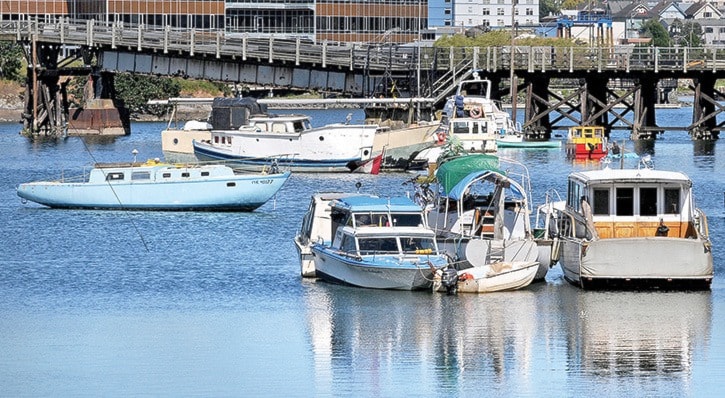Eric Ages used to cherish his early-morning rowing sessions along the Gorge waterway.
The slack tide at that hour creates a glassy surface in the protected inlet and provides one of the few year-round outdoor training sites in Canada.
But lately, as he slips into a rowing shell underneath the Selkirk trestle, Ages prepares for an increasingly common sight in the stillness of the surrounding waters: human excrement.
“I first noticed it last year,” said Ages, an administrator with GO Rowing and Paddling Association. “There’s no other explanation for what we’ve seen except human waste.”
He points to a collection of about 20 boats across the inlet, many of them permanently anchored, as the source of the raw sewage. Three vessels are tied together in a makeshift fashion, while another has an old Mexican blanket draped across the cabin door.
“And those boats sometimes drift. In the last month, we’ve had three rowing shells collide with boats that have drifted into our paths,” he said.
The small village of boats has flourished thanks to a jurisdictional smorgasbord that exists northwest of the Selkirk Trestle.
The provincial government owns the sea bed, while the federal government retains responsibility for navigable water regulations and marine habitat in the area.
On either side, Vic West and Burnside-Gorge community associations funnel complaints about abandoned or polluting boats to the City of Victoria, who themselves have long been looking for federal action on the matter.
On Thursday, councillors reviewed a staff report that attempts to cut through the buck-passing and provide the city with a feasible action plan.
“This is not something the city is anxious to leap into,” said acting mayor Geoff Young before the meeting. “And if the federal government were prepared to enforce the requirements with regards to discharge of sewage and interference with other vessels, we’d be happy to let them do so.”
Instead, Young suggests the city may have to look to a third party, such as the Greater Victoria Harbour Authority or a private marina operator, to avoid ballooning cost estimates. The third party could develop regulations and monitor compliance for anchored boats while consulting with the marine community, he said.
But first, the city needs to sort out a lease with the province and enforcement options with Transport Canada, the Department of Fisheries and Oceans and possibly even the Canadian Coast Guard.
“Our staff is very concerned about the costs, as I am,” Young said.
The CRD will be circulating a public questionnaire throughout the summer about all five harbour areas in the region to ask residents what they value, how they use the spaces and what concerns they have about future development.
The city, for its part, will continue to play musical chairs with various federal departments while it looks for a way to keep the Gorge from returning to its former polluted state.
“I realize there are jurisdictional clouds hanging over this body of water, but it’s our hope the City of Victoria will take swift action to resolve this,” Ages said.
